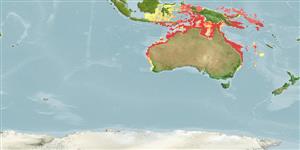分類 / Names
俗名 | 同種異名 | Catalog of Fishes(屬, 種) | ITIS | CoL | WoRMS | Cloffa
Elasmobranchii
板鰓亞綱 (鯊魚與魟魚) (sharks and rays) >
Orectolobiformes (Carpet sharks)
鬚鯊目 (Carpet sharks) >
Hemiscylliidae (Bamboo sharks)
竹鮫科 (Bamboo sharks)
Etymology: Hemiscyllium: hemi-, from hemisys (Gr.), half, presumably referring to similarity and/ or close affinity to Scyllium (=Scyliorhinus, now in Scyliorhinidae) and/or Chiloscyllium; skylion, Greek for dogfish or small shark (See ETYFish); ocellatum: Latin for eyed, referring to conspicuous white-ringed black ocellus on flanks above pectoral fins (See ETYFish).
More on author: Bonnaterre.
Environment: milieu / climate zone / depth range / distribution range
生態學
海洋 礁區魚類; 深度上下限 0 - 50 m (Ref. 54540). 熱帶; 1°S - 34°S, 112°E - 163°E (Ref. 54540)
Western Pacific: New Guinea and northern Australia. Possibly occurring in Malaysia, Sumatra (Indonesia), and the Solomon Islands.
西太平洋: 新幾內亞與澳洲北部。 可能出現在馬來西亞,蘇門答臘 (印尼) 與索羅門群島。
Length at first maturity / 大小 / 重量 / 年齡
Maturity: Lm ?, range 60 - ? cm
Max length : 107 cm TL 雄魚/尚未辨別雌雄; (Ref. 247)
背棘 (總數) : 0; 臀棘: 0. Caudal fin with a pronounced subterminal notch but without a ventral lobe (Ref. 13575). Lateral ocellus not surrounded by large spots; spots present on head in front and below eyes (Ref. 13575).
尾鰭有一個明顯的接近端位的凹槽但是沒有腹的葉.(參考文獻 13575) 側面的眼狀斑不包圍了大的斑點; 斑點位於在頭部的眼前面與下面之上。 (參考文獻 13575)
Commonly found in shallow water of coral reefs (Ref. 6871). Often in tide pools (Ref. 13575). Feeds mainly on benthic invertebrates (Ref. 6871). Oviparous (Ref. 50449). Squirms when captured but cannot readily escape (Ref. 247). Survives well in aquariums (Ref. 6871). Has the ability to survive low oxygen conditions by switching of non-essential brain functions; apparently an adaption for hunting in tide-pools with low oxygen (Ref. 52022).
普遍地棲息於珊瑚礁的淺水區。 (參考文獻 6871) 常見於潮池。 (參考文獻 13575) 主要吃底棲的無脊椎動物。 (參考文獻 6871) 卵生的.(參考文獻 50449) 蠕動當捕獲但是不能夠輕易地逃脫.(參考文獻 247) 存活很好地在水族館。 (參考文獻 6871) 有能力平安渡過非必要的腦功能的轉變溶氧量低環境; 顯然地在潮池中獵食的一個適應具有溶氧量低的.(參考文獻 52022)
Life cycle and mating behavior
成熟度 | 繁殖 | 產卵場 | 卵 | 孕卵數 | 仔魚
Oviparous, paired eggs are laid. Embryos feed solely on yolk (Ref. 50449). Prior to copulation, the male gets a good grasp of the female by by biting the body and even the gills (Ref. 49562, 51043).西太平洋: 新幾內亞與澳洲北部。 可能出現在馬來西亞,蘇門答臘 (印尼) 與索羅門群島。
Compagno, L.J.V., 1984. FAO Species Catalogue. Vol. 4. Sharks of the world. An annotated and illustrated catalogue of shark species known to date. Part 1 - Hexanchiformes to Lamniformes. FAO Fish. Synop. 125(4/1):1-249. Rome, FAO. (Ref. 247)
IUCN 瀕危狀態 (Ref. 130435: Version 2024-2)
無危 (LC) ; Date assessed: 18 February 2015
人類使用
漁業: 沒有興趣
工具
特別的報告
下載 XML
網路資源
Estimates based on models
Preferred temperature (Ref.
123201): 24.1 - 28, mean 26.9 °C (based on 262 cells).
Phylogenetic diversity index (Ref.
82804): PD
50 = 0.5020 [Uniqueness, from 0.5 = low to 2.0 = high].
Bayesian length-weight: a=0.00398 (0.00176 - 0.00901), b=3.09 (2.89 - 3.29), in cm total length, based on LWR estimates for this (Sub)family-body shape (Ref.
93245).
營養階層 (Ref.
69278): 3.4 ±0.2 se; based on diet studies.
回復力 (Ref.
120179): 低的, 最小族群倍增時間4.5 - 14 年 (Fec assumed to be <100).
Fishing Vulnerability (Ref.
59153): High vulnerability (64 of 100).
Nutrients (Ref.
124155): Calcium = 13.8 [2.7, 51.9] mg/100g; Iron = 0.395 [0.094, 1.067] mg/100g; Protein = 19.3 [17.1, 21.3] %; Omega3 = 0.0792 [, ] g/100g; Selenium = 30.9 [9.5, 86.3] μg/100g; VitaminA = 44.7 [15.7, 118.8] μg/100g; Zinc = 0.923 [0.453, 1.889] mg/100g (wet weight);
